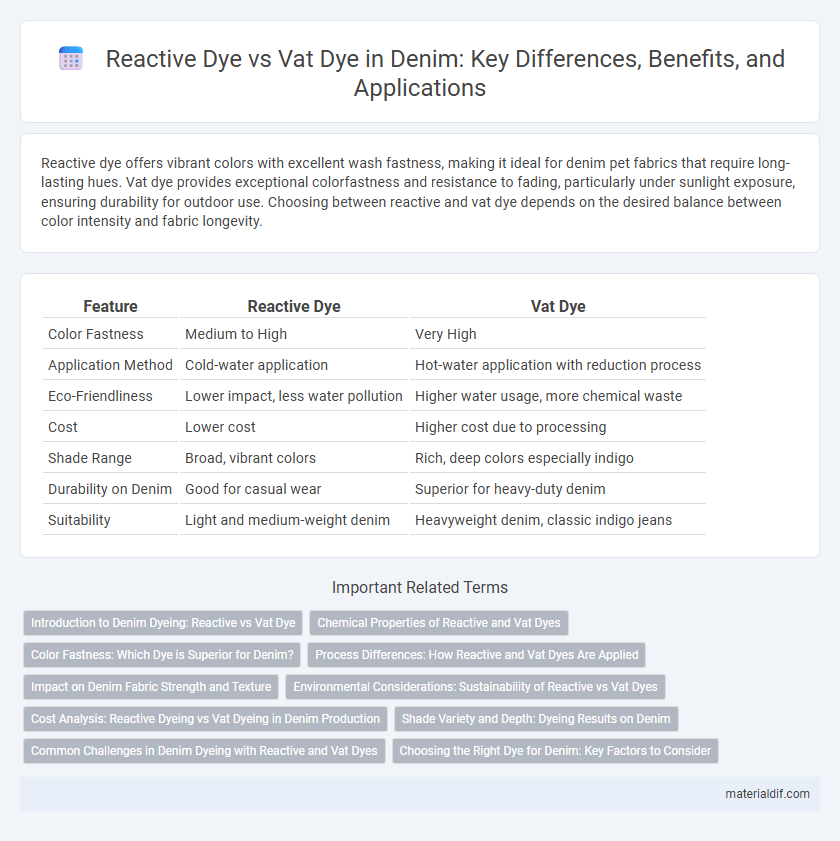Reactive dye offers vibrant colors with excellent wash fastness, making it ideal for denim pet fabrics that require long-lasting hues. Vat dye provides exceptional colorfastness and resistance to fading, particularly under sunlight exposure, ensuring durability for outdoor use. Choosing between reactive and vat dye depends on the desired balance between color intensity and fabric longevity.
Table of Comparison
| Feature | Reactive Dye | Vat Dye |
|---|---|---|
| Color Fastness | Medium to High | Very High |
| Application Method | Cold-water application | Hot-water application with reduction process |
| Eco-Friendliness | Lower impact, less water pollution | Higher water usage, more chemical waste |
| Cost | Lower cost | Higher cost due to processing |
| Shade Range | Broad, vibrant colors | Rich, deep colors especially indigo |
| Durability on Denim | Good for casual wear | Superior for heavy-duty denim |
| Suitability | Light and medium-weight denim | Heavyweight denim, classic indigo jeans |
Introduction to Denim Dyeing: Reactive vs Vat Dye
Denim dyeing primarily utilizes reactive and vat dyes, each offering distinct advantages in fabric coloration and durability. Reactive dyes chemically bond with cotton fibers, producing vibrant, long-lasting colors and excellent wash fastness, ideal for lighter denim shades. Vat dyes, such as indigo, provide deep, rich hues with superior colorfastness and distinctive fading characteristics, making them the traditional choice for classic denim aesthetics.
Chemical Properties of Reactive and Vat Dyes
Reactive dyes form covalent bonds with cellulose fibers through reactive groups such as monochlorotriazine or vinyl sulfone, providing excellent wash fastness and vibrant color in denim. Vat dyes are insoluble pigments that undergo a chemical reduction process to become soluble leuco forms, allowing them to penetrate denim fibers before oxidation restores their insoluble state, resulting in exceptional colorfastness and resistance to fading. Both dye types differ fundamentally in their chemical interactions with denim, with reactive dyes relying on fiber-dye covalent bonds and vat dyes depending on redox chemistry for fiber integration.
Color Fastness: Which Dye is Superior for Denim?
Reactive dyes exhibit strong color fastness on denim due to their chemical bonding with cellulose fibers, resulting in vibrant hues that resist washing and fading. Vat dyes, particularly indigo, penetrate denim fibers deeply and provide exceptional durability, enhancing resistance to light and abrasion over time. For long-lasting color retention and resistance, vat dyes generally outperform reactive dyes in denim applications.
Process Differences: How Reactive and Vat Dyes Are Applied
Reactive dyes bond chemically with cellulose fibers through a fixation process involving alkali and heat, typically applied in a pad-dry-cure method that ensures vibrant color and high wash fastness on denim. Vat dyes require a reduction process to convert them into a soluble leuco form before dyeing, followed by oxidation to restore insolubility and durability, commonly used in dip or jig dyeing techniques for deep, rich denim hues. The distinctive application methods influence the efficiency, environmental impact, and colorfastness properties of denim treated with reactive versus vat dyes.
Impact on Denim Fabric Strength and Texture
Reactive dyes form strong covalent bonds with cotton fibers, preserving denim fabric strength and maintaining a soft texture. Vat dyes penetrate deeply, resulting in durable colorfastness but can cause fabric stiffness due to intense chemical processing. Choosing between reactive and vat dyes impacts denim's hand feel and long-term wear performance.
Environmental Considerations: Sustainability of Reactive vs Vat Dyes
Reactive dyes offer superior environmental sustainability compared to vat dyes due to lower water and energy consumption during the dyeing process and reduced chemical discharge. Vat dyes require harsh reducing agents and alkaline conditions, generating more toxic effluents that challenge wastewater treatment and increase ecological impact. The lower fixation rate of reactive dyes also minimizes dye wastage, contributing to greener denim manufacturing practices.
Cost Analysis: Reactive Dyeing vs Vat Dyeing in Denim Production
Reactive dyeing in denim production generally incurs lower initial costs due to simpler application processes and less energy consumption, while vat dyeing demands higher investment in specialized equipment and stringent chemical handling protocols. However, vat dyes offer superior colorfastness and durability, potentially reducing long-term costs related to denim fading and product returns. Cost efficiency in reactive dyeing aligns with mass production and faster turnaround, whereas vat dyeing suits premium denim requiring enhanced performance and longevity.
Shade Variety and Depth: Dyeing Results on Denim
Reactive dyes produce a wide shade variety on denim, offering vibrant and bright colors due to their strong bond with cellulose fibers. Vat dyes provide deeper, richer hues with excellent fastness properties, resulting in a more saturated and long-lasting finish on denim fabric. Combining reactive and vat dyes can achieve diverse shade depths and finishes, enhancing denim's aesthetic appeal.
Common Challenges in Denim Dyeing with Reactive and Vat Dyes
Reactive and vat dyes present distinct challenges in denim dyeing, where reactive dyes often struggle with poor wash fastness and color fading due to weak fiber bonding. Vat dyes, despite superior wash fastness and color durability, face issues like complex reduction-oxidation processes and environmental concerns from effluent treatment. Managing these challenges demands precise process control and advanced dyeing technologies to optimize color consistency and sustainability in denim production.
Choosing the Right Dye for Denim: Key Factors to Consider
Reactive dyes provide vibrant colors and excellent wash fastness on cotton denim, making them ideal for maintaining brightness after repeated washes. Vat dyes offer superior colorfastness, particularly against light and abrasion, which is essential for durable denim products subjected to heavy wear. Choosing between reactive and vat dyes depends on prioritizing color brilliance versus long-term durability for the specific denim application.
Reactive dye vs Vat dye Infographic

 materialdif.com
materialdif.com